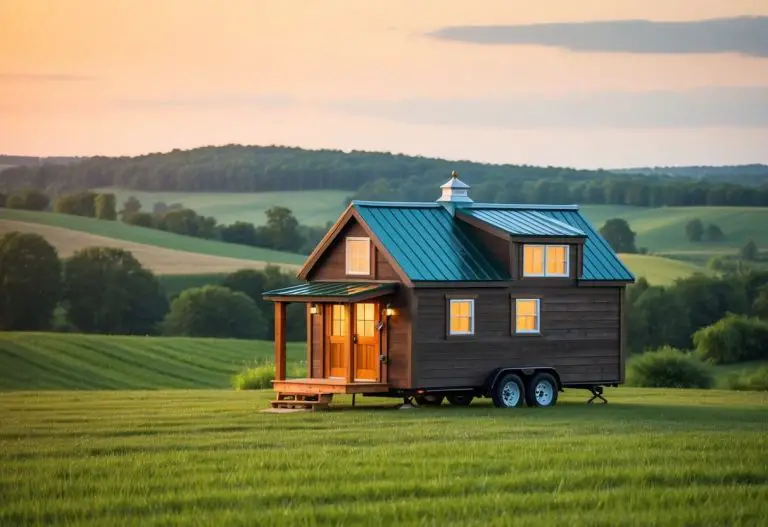Best RV Skirting for Winter: Essential Solutions for Cold Weather Protection
Winter camping in an RV can be a thrilling adventure, but staying warm is essential. Many RV owners overlook the importance of insulating the underbelly of their vehicles. This area is often exposed to freezing temperatures, which can cause discomfort and even damage to plumbing systems. Proper insulation not only keeps the heat in but also protects vital components from frigid weather.
Fortunately, there are various solutions to insulate an RV’s underbelly. From simple DIY methods to professional-grade products, options abound for every budget. Among these, innovative choices like AirSkirts make winter weather management easier and more efficient. Understanding these solutions can help RVers prepare for cold nights, ensuring a cozy and enjoyable experience on the road.
Why is it Important to Insulate RV Underbelly?
Insulating the underbelly of an RV is crucial for several reasons. First, it helps protect essential components from freezing temperatures. Pipes, tanks, and other equipment in the underbelly can be very vulnerable when the weather turns cold. If these components freeze, it can lead to costly repairs and an uncomfortable experience while traveling.
In addition, proper insulation can significantly reduce heating costs and energy consumption. By creating a barrier between the cold outside air and the warm interior of the RV, heating systems don’t have to work as hard to maintain a comfortable temperature. This not only saves money on fuel but also lengthens the life of the heating system.
Furthermore, insulating the underbelly can create a more pleasant living environment. Nobody enjoys a chilly draft on winter evenings. Effective insulation minimizes cold spots, making it easier to stay warm and cozy inside the RV.
Types of RV Underbelly Insulation
When choosing insulation for an RV‘s underbelly, there are two main types to consider: permanent and temporary insulation.
Permanent RV Underbelly Insulation is designed for those who live in their RVs full-time. This type often involves professional installation and is built to last. It is thicker and offers better thermal protection. Permanent insulation typically includes materials that have high R-values, which measure how effective it is at resisting heat flow. This kind of insulation ensures that the RV remains warm during long periods in cold weather.
Temporary RV Underbelly Insulation is ideal for casual RV users. It is easier to set up and remove as needed. This insulation tends to be more affordable and can include materials like foam boards or insulated RV skirting. These options allow flexibility for those who might travel to colder areas occasionally. Temporary insulation can provide sufficient protection against extreme cold without the commitment of a permanent solution.
Both types can help protect critical areas:
- Plumbing Lines: Insulating plumbing is essential, as frozen pipes can lead to leaks when they thaw.
- Holding Tanks: An insulated tank prevents waste from freezing, which can be both a health hazard and a major inconvenience.
- Electrical Wiring: Insulation helps protect wiring from icy conditions, ensuring systems continue to function properly.
Comparing Insulation Options
Here’s a quick comparison of the types of insulation:
| Type | Features | Cost | Best For |
|---|---|---|---|
| Permanent Insulation | Thick, long-lasting, high R-value | High | Full-time RVers |
| Temporary Insulation | Easy to install/remove, flexible materials | Low to Medium | Casual RV users, winter travelers |
In winter conditions, insulated RV skirting, which wraps around the bottom of the RV, is particularly effective. It reduces drafts and keeps the cold air away from the underbelly. Reflectix is another innovative option that provides a reflective barrier against cold, making it a popular choice for temporary insulation solutions.
Choosing the right insulation type depends on how much time the user plans to spend in colder environments. Permanent options offer durability and warmth, while temporary solutions provide convenience and flexibility. Regardless of the choice, both types work to create a warmer underbelly, helping RVers enjoy their travels even during the chilliest months.
Installing Insulation for RV Underbelly
Installing insulation for the RV underbelly can be a manageable task when approached correctly. Here’s a straightforward guide to help with the process.
-
Preparation: Begin with a clean slate. The underbelly must be dry and free of dirt. A thorough wash is recommended. If needed, scrub stubborn spots to ensure the surface is ready for insulation.
-
Selecting Insulation: Decide between permanent and temporary insulation. This choice will depend on how frequently the RV will be used and the types of climate it will encounter.
-
Gathering Tools: Basic tools are essential for this job. Required items include:
- Insulation material
- Utility knife
- Measuring tape
- Adhesive or fasteners
- Gloves for safety
-
Installation: Measuring accurately is critical. Measure the area under the RV, and then measure again to avoid any mistakes. Cut the insulation to ensure a snug fit without gaps. For more rigid materials, an adhesive should be sprayed on before laying them down. For fabric skirts, attach them securely around the edges of the RV. Many options come with snaps or Velcro, simplifying the installation process.
-
Testing: After installation, it’s wise to check for effectiveness. This can be done by feeling for any cold drafts or loose areas. If there’s any trouble, adjustments can be made. An overnight trip can be a practical way to see how well the insulation performs.
-
Final Touches: If issues arise during testing, further patches may be necessary. In some cases, it might be beneficial to consult with a professional for assistance.
With careful installation, underbelly insulation can turn an RV into a cozier space, making it much more enjoyable for seasonal travels.
What is RV Skirting and Does it Work?
RV skirting acts as a protective layer that wraps around the lower part of an RV, similar to a skirt. This fitting accessory serves multiple purposes, especially important during colder months. It is primarily designed to shield the undercarriage of the RV from cold air, drafts, and other harsh weather elements.
Key Features of RV Skirting:
- Insulation: Made from various insulating materials, RV skirting helps trap warm air inside the RV, contributing to a significantly warmer environment during chilly nights.
- Protection: It guards against snow, small animals, and debris, ensuring that the RV remains clean and safe.
- Cost-Effective: By improving insulation, skirting can reduce heating costs, making it more economical for those who frequently use their RV in winter.
Installation Considerations:
For skirting to be effective, it must fit snugly against the RV. Any gaps or loose areas can greatly diminish its insulating properties. Proper installation is crucial to ensure optimal performance.
RV Skirting Options:
- Custom Skirting: Tailored to fit specific RV models, which can be a bit pricier but ensures a snug fit.
- DIY Solutions: For budget-conscious individuals, there are creative ways to skirt an RV using materials like plywood or inexpensive fabric.
Overall, RV skirting is a practical solution for RV enthusiasts who want to enjoy their rigs year-round. With the right skirting in place, staying warm and comfortable in cold conditions becomes much easier.
Types of RV Skirting Materials
RV skirting materials come in various types, each with its unique features and benefits. Choosing the right material can help manage temperature and protect the RV from harsh weather.
Vinyl RV Skirting
Vinyl is a popular choice for RV skirting due to its flexibility and resistance to weather conditions. This material stands up well against rain and sun exposure. A quick wipe-down can restore its clean appearance. However, it may lose some of its pliability in freezing temperatures, so it is important to handle it gently in extreme cold.
Plywood RV Skirting
Plywood offers a classic approach to RV skirting. It provides a strong and sturdy barrier, making it effective against strong winds. Although installing plywood requires more effort, its durability is a key advantage. The weight of plywood can make storage challenging compared to lighter materials, but its strength often outweighs this drawback.
Foam Board RV Skirting
Foam board skirting is lightweight and provides adequate insulation. Rigid foam boards are easy to cut to size and secure in place. While foam boards offer good insulation, they might not hold up as well in windy conditions. Ensuring they are properly secured will help prevent them from being displaced by strong gusts.
Straw/Hay Bales
Using straw or hay bales is a natural solution for skirting. These materials effectively trap heat and block drafts, making them suitable for temporary setups. Additionally, they are biodegradable, which is an environmental benefit. However, this natural insulation can attract wildlife, so caution is advised if setting up in areas with active animal populations.
Tarps
Tarps offer a budget-friendly option for RV skirting. They can be used alone or layered to create a windbreak, helping to shield the RV from cold drafts. Tarps are readily available and quite simple to set up. It is important to note that while they can block wind, they do not provide significant insulation from the cold. Pairing tarps with other insulating materials can enhance their effectiveness.
Snow
Snow stands out as an unusual yet effective natural insulator for RVs. When piled around the RV, it can trap heat and serve as an emergency barrier in cold temperatures. Although snow is not a conventional skirting material, it can be a lifesaver if caught in unexpected winter conditions. Its effectiveness relies on the presence of snow, making it a temporary solution rather than a permanent one.
By considering these materials, RV owners can make informed decisions on how to best protect their vehicles from harsh winter weather.
RV Skirting Solutions
1. Inflatable RV Skirts
Inflatable RV skirts are among the most convenient options. These skirts are designed for quick setup and easy storage, making them ideal for travelers who don’t want a hefty installation process. Made from durable, puncture-resistant materials, these skirts fit snugly around the RV’s underbelly, providing an effective barrier against cold air.
Setting them up can be done in about 30 minutes using a pump. When it’s time to move, they can be easily deflated and packed away into a carry bag. Their design not only insulates but also ensures that RVers can shift from one campsite to another without hassle.
These skirts require some attention to size, as a perfect fit is essential for maximum effectiveness. A professional will often check the measurements before sending them out, which can aid in ensuring compatibility with various RV sizes.
While they provide a sleek and modern solution, cost can be a concern. They tend to be on the pricier side compared to other options. Still, for those seeking convenience without frequent reinstallation, they can be an excellent choice.
2. Ground-Secured Skirts
Ground-secured RV skirts are a more affordable solution that still offer innovation. This type of skirting boasts a unique fastening system that allows it to attach directly to any ground type, whether it is uneven or smooth. This adaptability makes it an attractive option for many campers who want dependable insulation.
The skirts work by creating an enclosed area underneath the RV that prevents cold air from entering. The installation process is relatively simple; heavy materials like rocks can help secure the skirt in place instead of needing to drill or use complicated tools.
They’re made from material that resists tearing and fading, ensuring durability. However, they can be lightweight, so extra care must be taken in windy conditions. Failure to secure them properly could lead to them moving or blowing away.
Though they come at a lower price, installation may still require minor skills. This option is ideal for those on a budget who still seek something that requires less intensive work than traditional renovation.
3. Snap-On RV Skirting
Snap-on RV skirts offer a sleek installation process that doesn’t require drilling or special skills. Constructed from sturdy vinyl and designed to withstand various weather conditions, they provide a robust alternative to traditional skirting methods.
These skirts utilize a special adhesive to stick onto the RV, creating a secure fit that remains resistant to both wear and weather. They can adapt to various RV styles, making them ultra-versatile. The easy installation involves snapping them into place, allowing for a quick setup and removal process.
Even though they are more durable than some other solutions, caution should be exercised during installation. The plastic components used for securing may not hold up against strong winds. Additionally, while they’re more reasonably priced than inflatable options, they still carry some expense.
These skirts are especially good for those looking to balance cost and convenience without compromising too much on durability. They offer flexibility for RVers looking for something more effective than basic DIY solutions.
4. Homemade RV Skirting
For those who enjoy crafting or are on a tight budget, homemade RV skirting can be a fun and creative solution. DIY skirting allows users to customize their approach based on materials and preferences, ranging from everyday items to more specialized products.
Common materials include:
- Plywood: This sturdy option can be cut to size and painted to match the RV. It’s easy to remove and assemble, making it a popular choice.
- Insulated Tarps: Unlike standard tarps, insulated versions can effectively block cold air. They can be fastened under the RV for added insulation.
- Foam Board Insulation: Easy to obtain from hardware stores, foam boards can provide a snug fit and are simple to attach.
- Straw or Hay Bales: A rustic option that offers insulation. Stacking bales around the RV can keep the cold out and adds a country feel.
- Bubble Wrap: Surprisingly effective, this lightweight material can temporarily insulate by trapping air.
- Reflective Insulation: These products reflect cold away, serving as a heat barrier.
With DIY skirting, creativity is key. Planning and preparing materials beforehand can make the process smoother and more enjoyable. While there may be more work involved upfront, it can lead to significant cost savings and a personalized result.
5. Tailored RV Skirting
Custom RV skirting is designed for those who want a perfect fit and are willing to invest in a premium solution. These tailored options are measured specifically for each RV model, ensuring maximum insulation and protection against harsh weather.
This type of skirting typically features high-quality materials that provide durability and effectiveness. Professional installation can often be arranged, which saves time for the RV owner.
Custom skirting eliminates the guesswork associated with fitting and installation. It’s especially beneficial for larger RVs where a standard option might not suffice. Once installed, it remains in place, requiring minimal adjustment during travel.
While this option tends to be more costly than other solutions, it can provide peace of mind during cold weather. The investment pays off in comfort and energy efficiency, making it a worthwhile choice for many RV enthusiasts.
Custom solutions present an opportunity for RVers to maintain a cozy living environment through the coldest months.
Our Verdict
When it comes to insulating an RV‘s underside, options abound to fit various skill levels and budgets. Among these, winter RV skirting stands out as the most effective choice for maintaining warmth during colder months. This solution is not only durable but also easier to install compared to other methods that can become complex and time-consuming.
A leading contender in this category is RV AirSkirts. Although it may come with a higher price tag, its unique combination of simplicity, portability, and effectiveness makes it hard to beat. This product protects against the chill without requiring extensive installation work or tools.
Alternatives are available for those who prefer a hands-on approach. Options like plywood skirts or vinyl materials offer various levels of insulation, catering to those who might enjoy a DIY project. These alternatives can be styled to enhance curb appeal, allowing RV owners to personalize their setup.
Key Options:
- RV AirSkirts: Easy to install, portable, and highly effective.
- DIY Solutions: Plywood, vinyl, and other materials for customization.
While it’s essential to keep functional needs in mind, enhancing the curb appeal of an RV shouldn’t be overlooked. Selecting a skirt that aligns with personal taste can make the rig feel more like home, even in frosty environments.
In this way, skirting not only adds insulation but also contributes to the overall aesthetic, making winter camping an enjoyable and comfortable experience.













